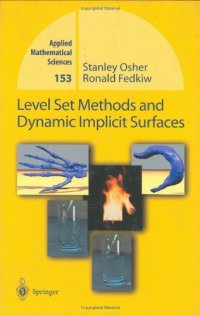
Ebook: Level Set Methods and Dynamic Implicit Surfaces
- Genre: Mathematics // Computational Mathematics
- Tags: Computational Mathematics and Numerical Analysis, Classical Continuum Physics, Image Processing and Computer Vision, Theoretical and Applied Mechanics
- Series: Applied Mathematical Sciences 153
- Year: 2003
- Publisher: Springer-Verlag New York
- City: New York
- Edition: 1
- Language: English
- pdf
This book is an introduction to level set methods and dynamic implicit surfaces. These are powerful techniques for analyzing and computing moving fronts in a variety of different settings. While the book gives many examples of the usefulness of the methods for a diverse set of applications, it also gives complete numerical analysis and recipes, which will enable users to quickly apply the techniques to real problems.
The book begins with the description of implicit surfaces and their basic properties, and then devises the level set geometry and calculus toolbox, including the construction of signed distance functions. Part II adds dynamics to this static calculus. Topics include the level set equation itself, Hamilton-Jacobi equations, motion of a surface normal to itself, reinitialization to a signed distance function, extrapolation in the normal direction, the particle level set method, and the motion of codimension two (and higher) objects. Part III is concerned with topics taken from the field of image processing and computer vision. These include the restoration of images degraded by noise and blur, image segmentation with active contours (snakes), and reconstruction of surfaces from unorganized data points. Part IV is dedicated to computational physics. It begins with one-phase compressible fluid dynamics, then two-phase compressible flow involving possibly different equations of state, detonation and deflagration waves, and solid/fluid structure interaction. Next it discusses incompressible fluid dynamics, including a computer graphics simulation of smoke; free surface flows, including a computer graphics simulation of water; and fully two-phase incompressible flow. Additional related topics include incompressible flames with applications to computer graphics and coupling a compressible and incompressible fluid. Finally, heat flow and Stefan problems are discussed.
A student or researcher working in mathematics, computer graphics, science, or engineering interested in any dynamic moving front, which might change it's topology or develop singularities, will find this book interesting and useful.
This book is an introduction to level set methods and dynamic implicit surfaces. These are powerful techniques for analyzing and computing moving fronts in a variety of different settings. While it gives many examples of the utility of the methods to a diverse set of applications, it also gives complete numerical analysis and recipes, which will enable users to quickly apply the techniques to real problems. The book begins with a description of implicit surfaces and their basic properties, then devises the level set geometry and calculus toolbox, including the construction of signed distance functions. Part II adds dynamics to this static calculus. Topics include the level set equation itself, Hamilton-Jacobi equations, motion of a surface normal to itself, re-initialization to a signed distance function, extrapolation in the normal direction, the particle level set method and the motion of co-dimension two (and higher) objects. Part III is concerned with topics taken from the fields of Image Processing and Computer Vision. These include the restoration of images degraded by noise and blur, image segmentation with active contours (snakes), and reconstruction of surfaces from unorganized data points. Part IV is dedicated to Computational Physics. It begins with one phase compressible fluid dynamics, then two-phase compressible flow involving possibly different equations of state, detonation and deflagration waves, and solid/fluid structure interaction. Next it discusses incompressible fluid dynamics, including a computer graphics simulation of smoke, free surface flows, including a computer graphics simulation of water, and fully two-phase incompressible flow. Additional related topics include incompressible flames with applications to computer graphics and coupling a compressible and incompressible fluid. Finally, heat flow and Stefan problems are discussed. A student or researcher working in mathematics, computer graphics, science, or engineering interested in any dynamic moving front, which might change its topology or develop singularities, will find this book interesting and useful.